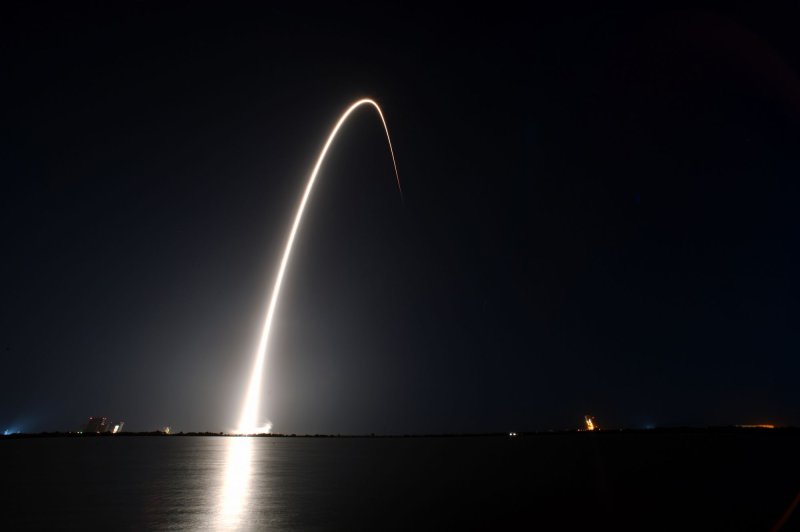1 of 3 | This timed exposure shows a SpaceX Falcon 9 rocket as it launches its 25th set of Starlink satellites on Wednesday from Complex 40 at the Cape Canaveral Space Force Station in Florida. Photo by Joe Marino/UPI |
License Photo
April 28 (UPI) -- Elon Musk's SpaceX successfully launched a Falcon 9 rocket into space late Wednesday, deploying its payload of 60 Starlink Internet network satellites into low-Earth orbit.
The two-stage, 70-meter rocket lifted off at 11:44 p.m. EDT as scheduled from Florida's Cape Canaveral Space Force Station.
Some nine minutes after liftoff, SpaceX recovered its first-stage Falcon 9 booster upon the football field-size drone ship Just Read The Instructions waiting on the Atlantic Ocean as the second stage continued on to its orbital destination.
"This marks our 81st successful recovery of an orbital-class rocket and again the seventh flight and seventh landing for this booster," Jessie Anderson, SpaceX's lead manufacturing engineer, confirmed during a live broadcast of the launch.
The second stage deployed its payload of satellites about an hour after liftoff into orbit at about 354 miles above the Earth's surface.
"Shortly they will deploy their solar array and over the next few days and weeks they will distance themselves from each other and use their on-board ion thrusters to make their way to their operational orbit," she said.
Weather was 90% favorable for the mission, SpaceX tweeted 30 minutes before liftoff.
Wednesday's launch was the 25th Starlink mission as part of SpaceX's plan to offer high-speed, low-latency Internet service worldwide through its constellation of Internet communication satellites that orbit the Earth.
On Tuesday, SpaceX received approval from the Federal Communications Commission of its modified Starlink plan to change the altitude of the next 2,814 satellites launched into space to 354 miles after the initial 1,584 satellites are in orbit at an altitude of more than 684 miles.
The plan was criticized by competing companies, including Amazon subsidiary Kuiper, that questioned the validity of the plan and said the satellites would interfere with other such systems.
Anderson said during the live launch broadcast Wednesday that more satellites at a lower orbit offer better service, but that being in low orbit aids with "debris removal" as the natural gravitation pull of the Earth will remove their hardware from space if they don't de-orbit following the end of their useful life as programmed.
"This is very different than traditional communication satellites at even slightly higher orbits that will be circling our Earth for hundreds of years," she said. "And unlike our Falcon 9 rockets, Starlink satellites are not designed to survive re-entry."
The satellites, she said, are designed to burn up when they re-enter the Earth's atmosphere.















